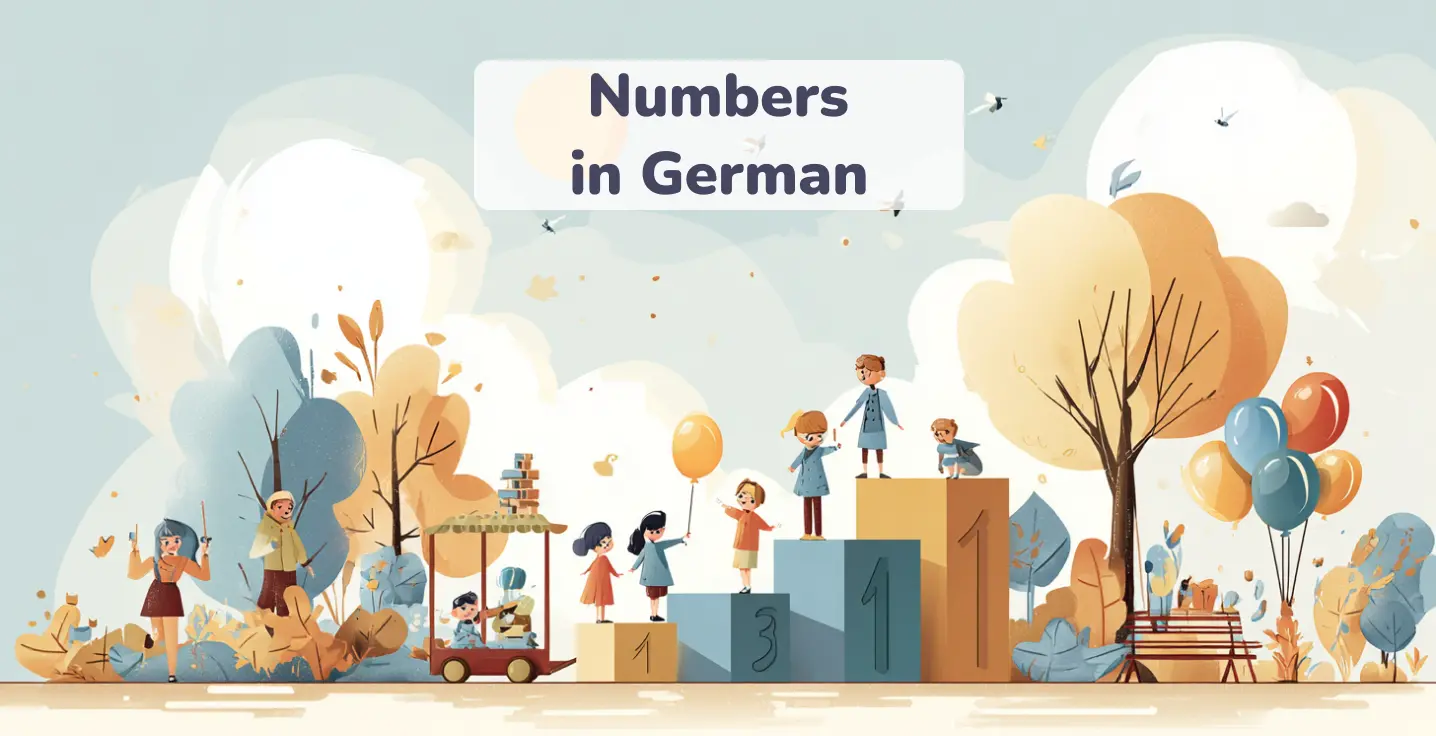What is the German pronoun?
Pronouns are used to replace nouns and avoid boring and dry speaking or writing, turning them into a native-like flow of your speech. In German, they are a little different from the English variants because they have to be adjusted to gender, number, and cases (we will review them later).
Pronouns in German can be applied to people, animals, and things, so by learning them, you expand your grammar knowledge and master all the essential skills needed to become a fluent speaker.
In this material, we will consider all the required information for you to have a guide with clear instructions on how to use it correctly, construct sentences, and more.
Level up your German with Koto!
Types of German pronouns
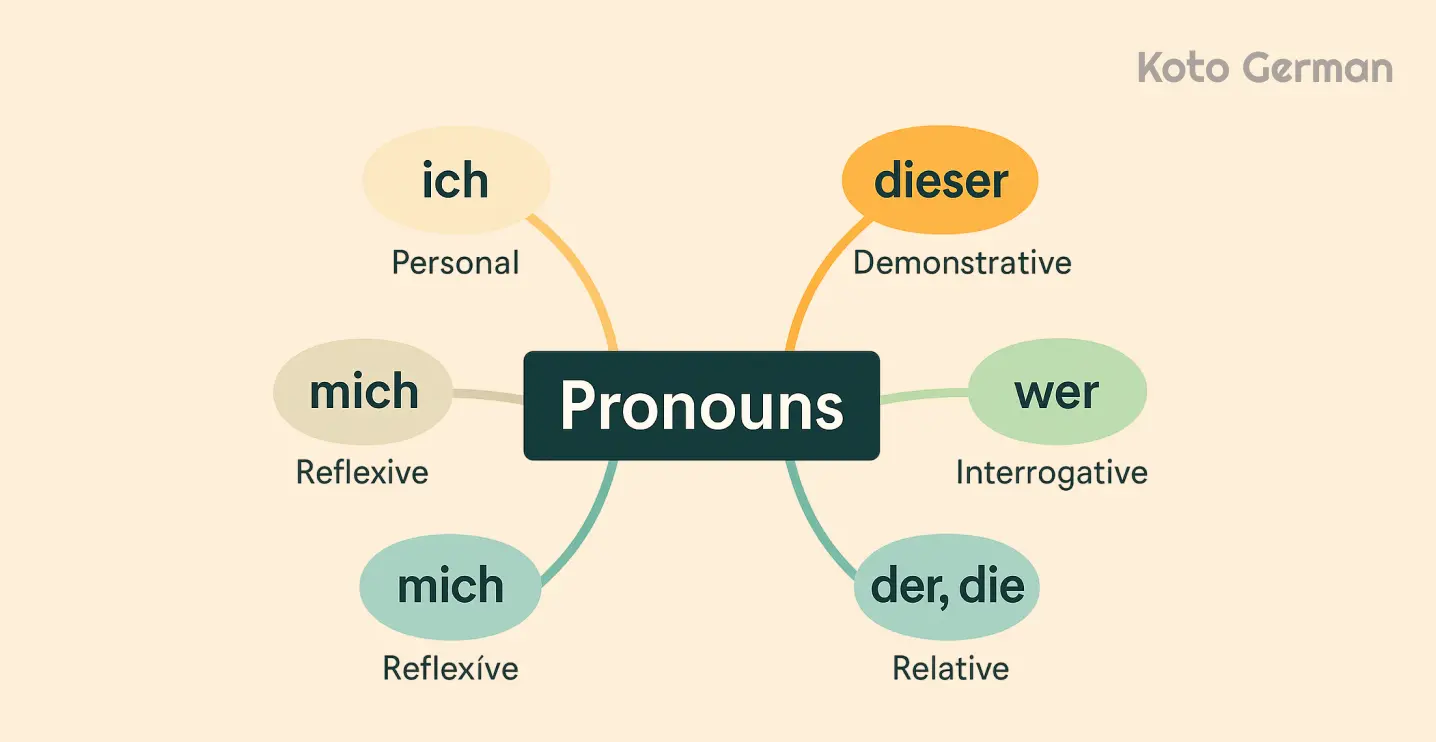
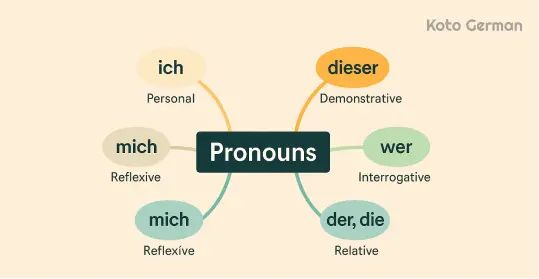
You already know why pronouns are important for German, as they are used to make your language richer, as you don’t need to name a thing or a person 30 times when describing them (which is actually too boring once you think about it).
It’s time to study all the kinds of terms that are used to replace nouns, using our German pronouns table we made for each of the types.
Here is a quick summary of the different types of German pronouns to help you understand their roles before exploring them in detail:
| Type of Pronoun | Example (DE) | Translation (EN) | When to Use |
|---|---|---|---|
| Personal | ich | I | Subject of the sentence |
| Reflexive | mich / mir | myself | Refers back to the subject |
| Possessive | mein | my | Indicates possession |
| Demonstrative | dieser | this | Points to something or someone |
| Interrogative | wer | who | Used to ask questions |
| Relative | der, die, das | who / which | Links dependent clauses |
| Indefinite | jemand | someone | When the subject/object is unknown |
Understanding the function of each pronoun type will help you use them correctly and make your German sound more natural. As you continue reading, you’ll see examples and grammar rules that bring each category to life, so keep this summary in mind as your foundation.
Overview of Pronouns in German
Personal pronouns


They are used to talk about things, animals, and humans in all situations, from common ones like speaking to a friend or relative, to formal ones like job interviews:
- ich
- du
- er
- sie
- es
- wir
- ihr (plural)
Common examples:
Reflexive pronouns
You can use this type to reflect on them (or yourself), indicating that they do something on their own, like “himself” in English:
- ich → mich/ihr
- du → dich/dir
- er/sie/es → sich
Common examples:
Possessive pronouns
If you want to note that something belongs to you or other people, you need to use this kind, and here are all of them to remember:
- mein
- dein
- sein
- ihr (her)
- unser
- euer
- ihr (their)
- Ihr (your formal)
Common examples:
Demonstrative pronouns
To point out something or someone that may be close to you, far away, indicate “the same,” and so on, you have to use:
- dieser
- jener
- derselbe
- derjenige
Common examples:
Interrogative pronouns
Using the named samples below, you will be able to ask simple and complex questions, as we can not imagine communication without this type of sentence:
- wer
- wen
- wem
- was
- welcher
Common examples:
Relative pronouns
When you need to identify a person or a thing with more detail, it is advisable to use a relative type:
- der
- die
- das
- welcher
- welche
- welches
Common examples:
Indefinite pronouns
In the case where you don’t know humans or things or can not name them (because you don’t see them or know anything about them), use:
- man
- jemand
- niemand
- etwas
- nichts
- alle
Common examples:
For now, you are aware of each type of pronoun and know what to practice and what to include for improvement in your daily learning. Further, we will consider some nuances about these German language pronouns that you have to remember.
How to Choose the Right Pronoun
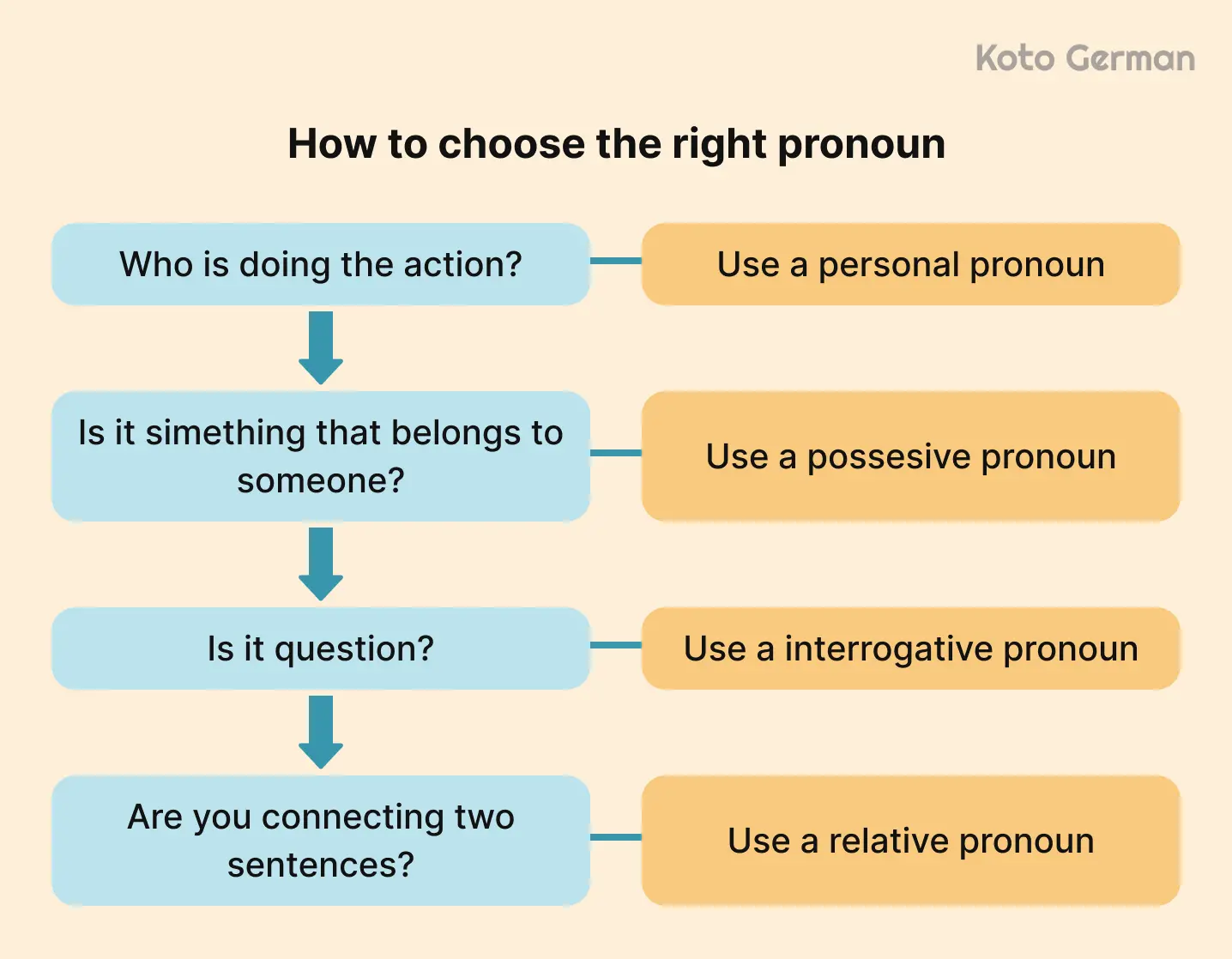
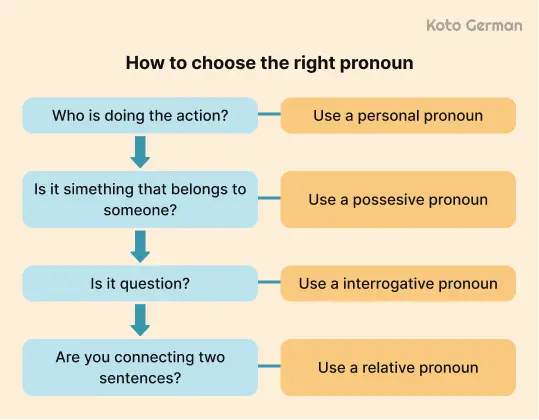
Not sure which German pronoun to use? Here’s a quick logic map:
Who is doing the action?
→ Use a personal pronoun: ich, du, er, etc.
Who receives the action?
→ Use an accusative or dative form.
Is it something that belongs to someone?
→ Use a possessive pronoun: mein, dein, etc.
Is it a question?
→ Use an interrogative pronoun: wer, was, etc.
Are you connecting two sentences?
→ Use a relative pronoun: der, die, das.
Think about what the word does in the sentence — subject, object, ownership, etc.
Declension tables for German pronouns
You have come to this point in our material, which means it is time to learn one of the most intricate grammar areas that defines how clear and natural your German is. It can be a completely new theme for learners whose first language doesn’t have declension (like English), so here, you will find the full explanation.
Let’s start with the four core cases:
- Nominative for the subject
- Accusative for the direct object
- Dative for the indirect object
- Genitive to demonstrate possession
Below, you will find how they change according to these cases, with real-world examples so you can use them in your daily communication.
Personal pronouns
| Person | Case | Nominative | Accusative | Dative |
|---|---|---|---|
| ich (I) |
ich
|
mich
|
mir
|
| du (you) |
du
|
dich
|
dir
|
| er (he) |
er
|
ihn
|
ihm
|
| sie (she) |
sie
|
sie
|
ihr
|
| es (it) |
es
|
es
|
ihm
|
| wir (we) |
wir
|
uns
|
uns
|
| ihr (you all) |
ihr
|
euch
|
euch
|
| sie (they) |
sie
|
sie
|
ihnen
|
| Sie (formal you) |
Sie
|
Sie
|
Ihnen
|
Examples:
Reflexive pronouns
| Person | Case | Accusative | Dative |
|---|---|---|
| ich |
mich
|
mir
|
| du |
dich
|
dir
|
| er/sie/es |
sich
|
sich
|
| wir |
uns
|
uns
|
| ihr |
euch
|
euch
|
| sie/Sie |
sich
|
sich
|
Examples:
Demonstrative pronouns
| Person | Case | Nominative | Accusative | Dative | Genitive |
|---|---|---|---|---|
| dieser (this) |
dieser
|
diesen
|
diesem
|
dieses
|
| jener (that) |
jener
|
jenen
|
jenem
|
jenes
|
| derselbe (the same) |
derselbe
|
denselben
|
demselben
|
desselben
|
| derjenige (the one) |
derjenige
|
denjenigen
|
demjenigen
|
dessenjenigen
|
Examples:
Interrogative pronouns
| Person | Case | Nominative | Accusative | Dative | Genitive |
|---|---|---|---|---|
| wer (who) |
wer
|
wen
|
wem
|
wessen
|
| was (what) |
was
|
was
|
– | – |
| welcher (which) |
welcher
|
welchen
|
welchem
|
welches
|
Examples:
Relative pronouns
| Gender | Case | Nominative | Accusative | Dative | Genitive |
|---|---|---|---|---|
| Masc. |
der
|
den
|
dem
|
dessen
|
| Fem. |
die
|
die
|
der
|
deren
|
| Neut. |
das
|
das
|
dem
|
dessen
|
| Plural |
die
|
die
|
denen
|
deren
|
Examples:
All these tables seem like a lot to do, and that’s true, but let us save you from mechanical memorization as you can learn all these pronouns in German language in life-like context, connecting them with situations that happen daily — in a supermarket, at school, etc.
Common learner mistakes
The proper way to avoid mistakes is to be aware of them, and especially about those that are typical for most students. You will read about ones that take place in communication, reading, writing, and which impact your fluency.
Confusing du and Sie
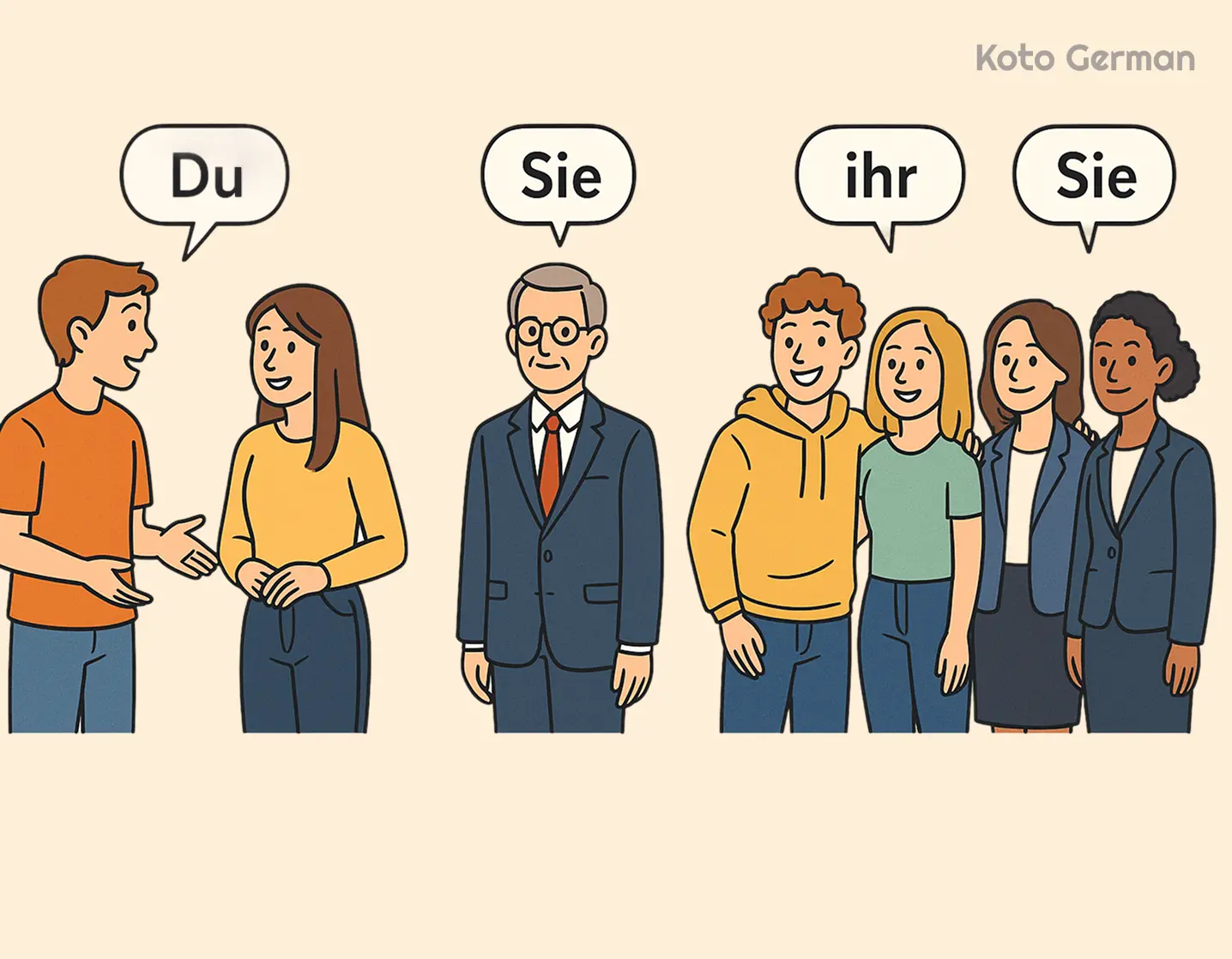
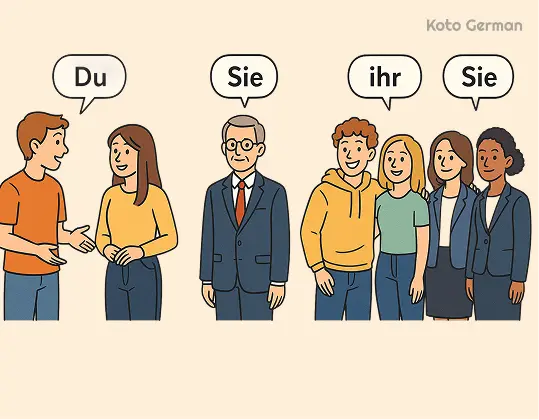
Informal and formal words can be challenging for new learners and can cause misunderstandings in social interactions with other people, who may be your friends or just strangers.
Du is a term used for casual conversation, and in English, it is a simple you that can confuse students even more. The tip here is to remember this part of grammar and in the list of German pronouns, differentiate du as the one used for close people.
When it comes to Sie, it has a wide usage for older people, strangers on the street when you need to ask directions, your colleagues, and so on. In such a way, you show respect, which is essential in formal situations.
|
Du bist Herr Armin, oder?
|
Sind Sie Herr Armin?
|
|
Sie sind mein Freund.
|
Du bist mein Freund.
|
Mixing up accusative and dative
These cases are tricky because non-natives need to learn the rules, as there is no intuitive navigation between them. To remember it well, you need to memorize that the accusative is used for naming direct objects, while the dative is used for indirect objects only.
You need to study dative verbs carefully, and use these pronouns according to their usage, focusing on objects, indirect and direct ones.
|
Ich sehe dir.
|
Ich sehe dich.
|
|
Ich danke dich.
|
Ich danke dir.
|
Ignoring pronouns to avoid repetitiveness
Using a pronoun in German is not a walk in the park but it is the way to improve your speech and writing skills, so here is a review of the mistakes that take place in the studying process among new learners.
To make your German more natural and fluent, it is essential to use these terms and align them with cases (we have considered them), gender, numbers, and more. Here is how it works:
|
Das Auto ist neu. Das Auto ist rot.
|
Das Auto ist neu. Es ist rot.
|
|
Der Mann nimmt den Apfel. Der Mann isst den Apfel.
|
Der Mann nimmt den Apfel. Er isst ihn.
|
Mistaking genders
German is more complicated in pronouns because you need to differentiate gender even for things, not only for people. It means that you can’t use er for a female (talking to a girl or a woman), and using it this way will sound weird.
Here are some samples:
|
Der Junge ist nett. Sie spielt Fußball.
|
Der Junge ist nett. Er spielt Fußball.
|
|
Die Tasche? Ich habe ihn nicht.
|
Die Tasche? Ich habe sie nicht.
|
Summing up, you know about the core errors to pay attention to, so you can avoid them by practicing more and more, using relevant resources. Don’t be afraid of mistakes as we all make them — even native speakers — so put your efforts into constant studying, and check out our advice to make it more effective below.
Enjoy personalized learning!
Practice Time: Select the Right Pronoun
The best way to memorize this theme is to make some engaging exercises that will help you to master pronouns knowledge. Here, you will find three activities that consider how you studied the terms and train your context understanding.
Study tips for learners
To learn faster, you need to use some recommendations that improve the workflow of your studying process and reduce the workload, as German is not the easiest language to choose for learning.
Here, we gathered the most helpful advice from students worldwide to help you with all German pronouns:
Tip 1. Add flashcards and spaced repetition.
There is nothing better for memorization than repetitive practices, as you keep recalling the information, and it stays in your memory forever with time. If you are an analog person in love with paper and pen writing, you can make flashcards on your own, using a notepad. If you are more interested in the digital version, consider downloading apps like Quizlet and Anki to your tablet or phone.
How can it be helpful in other ways? Combined with active learning, it reduces the time you need to memorize complex pronouns as your brain will remember them, and you can skip those you already know so you don’t spend extra time.
Tip 2. Turn to native content.
This advice reflects on the fact that you will use German in daily life, for work or at school, while reading books, ads, and so on. So another proven way to make learning more pleasurable and faster is to choose materials with simple grammar and vocabulary, like for children, and watch videos to perceive dialogs from natives.
Tip 3. Use speaking drills for more fluency.
You need to learn how to talk using a German pronouns list, and this type of activity is one of the top and is implemented by many schools as they use games to make the study more engaging. You can do it on your own, for example, finding a pic on Pinterest or else, filled with people, and describe what you see there (using as many terms as you can).
Stay active and enjoy the learning process using the tips above, and see what works the best for you and matches your style.
Conclusion
For now, you are a pro when it comes to the usage of the named terms in German, from personal, which replace names, to possessive to showcase ownership to someone. To master this language topic, keep practicing with engaging exercises, spending as much time as you can daily. Check out our next material, “German Cases Made Simple,” and gain more knowledge.
FAQ: Common questions about pronouns in German
When both sie are written without capital letters, it can be difficult to recognize which one is used — “she” or “they.” The point here is to focus on context and pay attention to the verb form. Here is how it works:
Mostly, yes, you can use this word if you want to refer to “one,” meaning the general subject in a sentence, but not a concrete person. It means “someone” in English and is used the same way, let’s look at it here:
Note to use it referring to people abstractly and don’t confuse it with der Mann, which means the man as a person (masculine form).
As always, the devil is in the details — in context, if we are talking about our case. Still, it is pretty simple as you dive into this topic because typically, you differentiate between them as the formal and informal usage.
Here is a simple table for more understanding:
| English/German | Usage | Example |
|---|---|---|
| ihr/Ihr – her/their | Singular and plural, informal and formal |
Ist das
Das ist
|
| euer – your | Plural and informal |
Ist das
Ich mag
|
How to know where to use them? — Pay attention to the function words you have learned above and practice more with reliable activities.
It is recommended to use Sie (with the capital letter, don’t misplace it with sie) for both plural and singular nouns. Moreover, it allows you to show respect to all people outside, despite their professions, age, and other nuances.
Example:
Yes, and it is one of the most challenging themes for learners who are used to English variants, where you use terms in the same form in every sentence. In German, you have to change them according to four cases:
- Nominative refers to the subject and is common for you now: ich, du, er, sie, es for singular and plural wir, ihr, Sie, sie.
- Accusative is used for the object and is presented through pronouns mich, dich, ihn, sie, es for singular and plural uns, euch, Sie, sie.
- Dative is met when you talk or read about the indirect object, or it has some specified prepositions and includes words mir, dir, ihm, ihr, ihm for singular and plural uns, euch, Ihnen, ihnen.
- Genitive is rarely used in German now and corresponds to forms meiner, deiner, seiner, etc.





